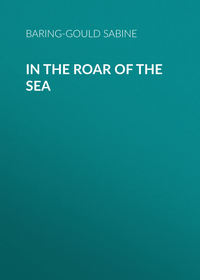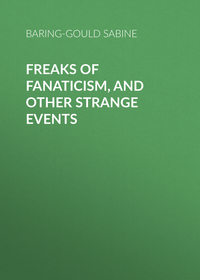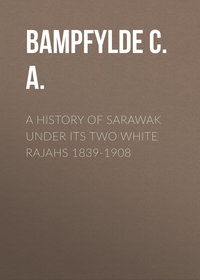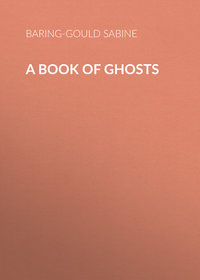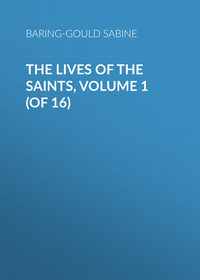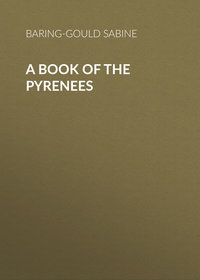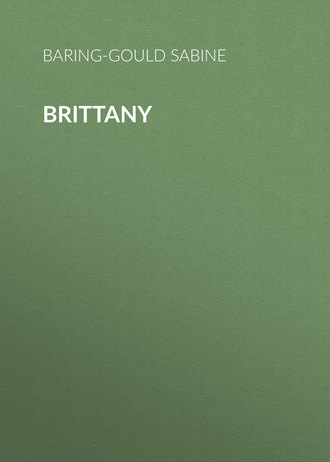 полная версия
полная версияBrittany
For five hundred years this continued. Brittany writhed and strove for her independence, and had no desire to become either a province of France or an English colony. The war broke out under Duke Hoel in 1076 when he invoked the aid of Philip I. against William the Conqueror. However, under Alan Fergant and Conan III. the land had rest for eighty years, and then the trouble began again with renewed violence. Conan's death in 1148 gave rise to a war of succession that lasted eight years. Conan IV. assisted by the English succeeded in establishing himself in the ducal seat, and he favoured the English in every way. Henry II. of England married his son Geoffrey Plantagenet to Constance, daughter of Conan IV., the heiress of Brittany, and Geoffrey was crowned at Rennes in 1169. This was of advantage so far that it introduced Norman civilisation into a duchy that was backward and barbarous. The churches built in the 12th century were erected by architects of the Norman and French schools. Such are the cathedrals of S. Pol-de-Léon and S. Malo and the churches of Guérande. Geoffrey died in 1187, and his son Arthur fell into the hands of his uncle, King John, who had him murdered at Rouen (1203). Constance did not die broken-hearted and despairing, as represented by Shakespeare, but married Guy de Thouars, and had by him a daughter and heiress, who was married to Pierre de Dreux.
We may pass over the ensuing history till we reach John III. who died in 1341, without issue, and who, hating his half-brother, Jean de Montfort, bequeathed the succession to his niece Jeanne de Penthièvre, whom he married to Charles de Blois, nephew of Philip VI. of France. This was the signal for the outbreak of the terrible and desolating War of the Succession of the two Jeannes. In it, neither of those most interested were for the most part of the time leaders of their hosts. At the outset Jean de Montfort was taken prisoner (1342), and was kept in prison till his health was broken, and he was discharged only to die (1345). But his intrepid wife Jeanne of Flanders carried on the conflict. At the Battle of La Roche-Derrien (1347) Charles of Blois was captured and conveyed a prisoner to England, and the conduct of the war fell to his wife Jeanne. The English espoused the side of Montfort, and the French that of Charles of Blois. The success of the battle of La Roche was followed by the signal victory of Mauron (1352). The war dragged on, and Charles was released in 1356, to renew the contest with fresh cruelty. He had now as his best assistant Bertrand du Guesclin, an heroic and honourable soldier, and one of the best captains France has produced. But in the decisive battle of Auray (1364) Charles was killed, and Du Guesclin taken prisoner. A few months later, Jean de Montfort the younger was recognised duke under the title of John IV. But the war was not at an end. Now that Charles was dead, the Bretons of Penthièvre rallied about Oliver de Clisson, and the old strife continued under other names.
The country was ravaged by Companies, under commanders who passed from one side to the other as suited their convenience. John IV. attempted to have Clisson assassinated in Paris (1392). The attempt failed, and served only to exasperate Clisson and aggravate the war. It was resolved into a family vendetta. In 1420 Oliver de Clisson, grandson of Charles de Blois, and of Oliver, treacherously obtained possession of John V. and imprisoned him. A war ensued, and before the duke could be liberated, much blood was shed; as the cause of the Penthièvre family was not, on this occasion, espoused by France, it was crushed and the apanage of Penthièvre was confiscated.
Francis I. (1442-50) conceived an animosity against his brother Gilles de Bretagne whom he accused of favouring the English. He delivered him over to his mortal enemy, who starved the unhappy prince to death. Pierre II. succeeded, but as he died without issue, as well as Francis, the succession passed to Arthur of Richmond their uncle. He was succeeded by Francis II. who died in 1488, leaving an heiress, Anne, who married first Charles VIII. of France (1491), and on the death of Charles (1498) married Louis XII., and thus, the duchy was finally united to the crown of France.
The Reformation made no way with the people of Brittany, but was embraced by the Rohan, the Rieux, the Laval, and other noble lords, who coveted the estates of the Church. The chateaux of Blain and Vitré were for a while centres of Huguenot propaganda in Brittany. The province would, however, have remained at peace, but that its governor, the Duke de Mercœur was a devoted adherent to the house of Guise, and he proposed to make of Brittany a stronghold of the League. When Henry IV. came to the throne in 1589, he was a Calvinist. There were three parties in Brittany mutually antagonistic, the Leaguers supported from Spain, the Huguenots and the Royalists. The city of Rennes, without abandoning the Faith remained true to Henry IV. Nantes became the headquarters of the League. The Huguenots, from Vitré, and the castles of the family of Rohan, swept the country ravaging and burning. Nine years of war ensued between 1589 and 1598. A swarm of brigands placed themselves under the flag of the League, or of the King or of the Bible, and wrought intolerable misery. Moreover, the peasants, maddened by their sufferings, rose against all alike, besieged the castles indiscriminately and massacred every man in harness. Brittany was almost depopulated, and wolves preyed on human corpses in the open day. One of the worst ruffians of this period was Fontenelle, a cadet of the Breton family of Beaumanoir. He sacked Roscoff, Carhaix, and ravaged the diocese of Tréguier. But his worst atrocities were committed at Pont l'Abbé and Penmarch, which was once a flourishing town rivalling Nantes, but which has never recovered the butcheries there committed by Fontenelle, and its ruined houses have never been rebuilt. The atrocities committed by him at Pont l'Abbé defy description. He delighted in seating his victims on iron chairs and broiling them to death, or in immersing them in mid-winter in vats of ice-cold water, and thus leaving them to perish in dungeons. In some parishes visited by him, where the population had numbered a thousand adults, he reduced it to twelve. To the miseries produced by civil war succeeded a Black Death, which almost completed the depopulation. Fontenelle was taken in 1598, but pardoned; he was arrested for fresh crimes in 1602, and slowly tortured to death.
The province remained in peace till 1675, when taxation became so burdensome, that the people rose in insurrection. It was put down with great barbarity.
We pass on to the Revolution, and to the noble stand made by the Breton peasantry against the bloodthirsty ruffians, who had grasped the reins of power. Liberty, Equality and Fraternity in the mouths of these latter meant Tyranny, Robbery and Massacre. Again the soil of Brittany was drenched in blood. The curés were hunted like wild beasts, and when caught were hung, guillotined or shot. Under the Terror the moderate Breton deputies who belonged to the party of the Girondins had to fly for their lives. The Convention sent down into Brittany Carrier and others, the scum of humanity to "purify" the country. Twenty eight Girondists were guillotined at Brest. Anyone who was held suspect was at once sent to his death. The Loire at Nantes was choked with the bodies of inoffensive men, women and children, drowned in the Noyades.
The Chouans, as the peasants were called who rose against their tyrants, were commanded in Morbihan by Cadoudal. In July, 1795, an English fleet disembarked several regiments of French emigrés. Hoche came upon them, and exterminated all in cold blood, to the number of 952. Nantes and S. Brieuc were taken by the peasants, but the firm hand of Bonaparte now held the reins, and put down all opposition. Cadoudal was guillotined.
At the present day, Brittany is still the stronghold of Catholicism in France. As to the rights of legitimists, Orleanists or Bonapartists, the peasants concern themselves little, but to touch their religion is to touch them to the quick. The Republican Government does all in its power to destroy the cohesion of the Breton people, and its attachment to the Faith of its Fathers. The masters have been forbidden to employ the Breton language in the schools, and in 1901 an order was addressed by Waldeck Rousseau to all the Bishops and Clergy of Lower Brittany forbidding them to preach in the language understood by the people, on pain of withdrawal of their stipends: an order that has been very properly disregarded.
Meanwhile national or rather provincial feeling is deepening and intensifying. Opposition only makes the Breton the more stubborn. The Breton has not much ambition. All he asks is to be left alone to work out his own destiny, strong in his religious convictions, "Français – oui, mais Breton avant tout."
IV. Antiquities
The prehistoric remains that abound in Brittany consist of Dolmens, i. e. a certain number of stones set on end rudely forming a chamber, and covered with one or more capstones.
The Allée Couverte is a dolmen on a large scale. Both served as family or tribal ossuaries.
The Menhir is a single standing stone; the alignment is a number of these uprights often in parallel lines, extending some distance.
The cromlech according to the signification accorded to it in France is a circle of standing stones.
The lech is the lineal descendant of the menhir. It is a stone often bearing an inscription, or a rude cross, set up by the British or Irish settlers. The lech is sometimes round.
Tumuli and Camps are numerous, but they are not often referred to in the following pages.
Of Roman remains, there are relics of an aqueduct near Carhaix, and there have been numerous villas uncovered, notably near Carnac, but these are almost all recovered with earth. The most remarkable Roman monument extant is the Temple of Mars, a fragment near Corseul.
The Venus of Quinipili, a Roman Gallic idol, shall be spoken of under the head of Baud.
Of early churches, – earlier than the 10th cent. there are none, there are but the crypt of Lanmeur and perhaps the arches and piers of Loconnolé near Morlaix, and possibly the Western arches of Plouguer by Carhaix that can be attributed to the 10th century. After that come considerable remains of Romanesque churches, beginning with the plain unmoulded round arch resting on plain rectangular piers, and gradually becoming enriched. (11th century and beginning of 12th.)
First pointed, with lancet windows, no tracery, and arches struck from two centres. (Middle of 12th century and beginning of 13th.)
Second pointed or Geometrical. Tracery becomes rich in windows, but always of a geometrical design. (Middle of 13th century and throughout 14th.)
Third pointed or Flamboyant. Tracery like flame, recurving, gradually all cusping abandoned. Arches employed in ornamentation struck from four centres. (15th century and beginning of 16th.)
Rénaissance. At first classic detail with Gothic outline, and tracery in its last decay. At last all tracery abandoned, and design stiffens and loses all Gothic feeling. (Middle of 16th century to middle of 17th.)
Baroque. Round headed windows, no tracery, clumsy mouldings, no taste whatever, but barbarous enrichment. (End of 17th century and 18th.)
V. The Pardons
The Pardons are the religious gatherings of the people, not often in the towns, but about some chapel on an island, on a hill top, in a wood. There may be seen the costumes in all their holiday beauty.
A Pardon begins with vespers on the night before the Feast. Pilgrims arrive for that, and sleep in the church, the chapel, under hedges. They sing their cantiques or hymns till they sing themselves to sleep. The first mass is said at 3 A.M. and the true pilgrims communicate till the last has received, when they depart. An ordinary visitor arriving, say at 10 A.M., will hardly see a single pilgrim. The rest come to join in the devotions. They attend mass, take part in the afternoon (3 P.M.) procession, and buy memorials, and ribbons, and sweetstuff, and pictures at the stalls.
Almost every Pardon has a character of its own, and a description of one by no means attaches to all. In Côtes-du-Nord the Pardon is only found genuine in the Breton speaking portion, elsewhere it has degenerated into an ordinary village feast.
Sometimes, and in some places, there is an evening procession carrying lighted candles, in some a bonfire figures lighted by a figure of an angel which descends from the chapel or church spire. At some there are wrestling and games in the afternoon, at others there is dancing, but usually all is quiet and the peasants disperse after the afternoon procession.
By the sea, the arrival of the boats with maidens in white and banners is a pretty sight; at one Pardon, the sailors proceed, barefooted in their shirts, in performance of a vow, when delivered in a storm.
A visitor who desires to be present at one of the most popular Pardons should secure rooms a month beforehand, and even then he may be dispossessed if the Government or military authorities have seized on the occasion of a Pardon to billet a regiment on the place, an experience the writer has twice had to undergo.
Another quarter century will probably see the last of the Pardons. It will not be due to the decay of the religious feeling among the people – that need not be feared – but to Governmental opposition, and the indecent behaviour of the tripper, which will perhaps induce the clergy to discourage them. (Matt. vii. 6.) A word to the invariably courteous and kindly curé will often secure for the visitor a place of vantage in the gallery, and it is only due to him to ask if he objects to a snap-shot with the kodak at the procession. To photograph a man when engaged in his devotions, or a woman making her painful pilgrimage barefooted is not calculated to impress the peasant with the good-feeling of the English visitor. The Breton is tender-hearted and sensitive, and should ever be respected. At a great Basse-Bretagne Pardon and fair, one may wander till late among the thousands gathered there, enjoying themselves on merry-go-rounds and at shooting stalls, and see no horseplay, no rudeness, no drunkenness.
At a Pardon one sees and marvels at the wondrous faces of this remarkable people: – the pure, sweet and modest countenances of the girls, and those not less striking of the old folk. "It is," says Durtal (En Route), "the soul which is everything in these people, and their physiognomy is modelled by it. There are holy brightnesses in their eyes, on their lips, those doors to the borders of which the soul alone can come, from which it looks forth and all but shows itself."
Goodness, kindness, as well as a cloistral spirituality stream from their faces. One incident may be noticed to show of what stuff their charity consists. After the wreck of the Drummond Castle when the bodies were washed up on the Ile-Molène, the women readily gave up their holiday costumes – costumes which it takes a girl twenty years of economies to acquire – and in these they clothed and buried the dead women washed ashore.
The Pardons in the Bigauden district are the most showy. The Bigaudens delight in bright colours, but they are not a religious or a moral people, and they do not exhibit the fervent and deep-seated piety of the genuine Bretons. The Bigaudens occupy the promontory of Sizun and Pont l'Abbé. This people, peculiar in appearance and distinct in character from the Bretons, are supposed to belong to the primitive population of Ivernians before the coming of the British colonists. They are looked on with mistrust, if not aversion by the Bretons, whom they can generally over-reach in a bargain.
VI. Iconography
It may interest some travellers to be able to identify some of the more common Saints of Brittany whose statues are to be found in the churches, chapels, and over the Holy Wells. A few of the Roman Saints are added who are thrusting the native ones from their niches.
Ste. Anne, with the B.V.M. at her side, sometimes with her on one arm and Christ on the other.
S. Armel, in a brown habit, with a cap on his head, an amice over the right shoulder, with a dragon whom he holds by a stole.
Ste. Aude or Haude, as a damsel carrying her head.
S. Bieuzy, as a monk with his head cleft.
S. Brioc, as a bishop with a wolf licking his feet.
S. Budoc, as a bishop with a barrel at his side.
S. Cadoc, as an abbot holding a bell.
S. Corentin, as a bishop carrying a fish.
S. David, as an archbishop with archiepiscopal crozier.
S. Edern, as a monk riding on a stag.
S. Efflam, in ducal habit, with sceptre, treading on a dragon.
S. Fiacre, in brown habit, holding a spade.
S. Fingar, Eguinger, or Guingar, as a prince, with sword and palm branch.
S. Gildas, in monastic habit, with a snarling dog at his feet.
S. Gwen Teirbron, seated, with crown, and three breasts, her children on her knees or at her feet.
S. Gwénole (Winwaloe), as an abbot, no special symbol.
S. Haude, a damsel carrying her head.
S. Herbot, as an anchorite with an ox at his feet.
S. Hervé, as a blind monk, a boy or a wolf at his side.
S. Meliau, as a king or duke, bearing sword and palm branch, or sceptre.
S. Melor, a boy with one hand and one foot cut off.
Ste. Ninnoc, in robes as a nun, a stag at her feet.
Ste. Noyala, as a princess holding her head in her hands.
S. Paul of Léon, in episcopal habits, treading on a dragon, and with a bell in his hands.
S. Samson, as archbishop.
S. Solomon, in royal robes, and with a dagger in his breast.
S. Thégonnec, as a bishop with a cart drawn by wolves.
S. Theilo, as an abbot or bishop riding on a stag.
S. Tujean, as a bishop with a mad dog at his side.
S. Vincent Ferrier, in monastic habit, holding a trumpet, and with wings.
S. Yves, in a white robe with long sleeves and doctor's bonnet, giving judgment sometimes between a rich suitor and a poor man.
S. Anthony of Padua, as a Franciscan, with the Child Jesus on one arm.
S. Barbara, with a tower at her side.
S. Cornelius, as Pope, with an ox at his feet.
S. Eligius, as bishop, with a horse at his side.
S. Isidore, dressed as a Breton peasant in bragoubraz (baggy breeches), holding a sickle.
S. Joseph, aged and holding a lily, sometimes with the Child Jesus on his arm.
S. Roch, as a pilgrim showing a wound in one leg.
VII. General Instructions
In the humblest village one may reckon on obtaining good meals, but not always on having dry sheets. It is not customary to air the latter, and except in hot dry weather, it is well to be on one's guard in this matter. Water should never be drunk. Too frequently it is drawn from the well in the yard, and is contaminated. Coffee in out of the way parts, even at such headquarters as Carhaix, is not coffee at all, but roast lupin berries.1 The ordinary charge for déjeuner at 11.30 is 2.50, with cider and coffee, and 3 francs for dinner at 7 p.m. But in second class inns is 50 centimes less. A bed is usually 1.50 or 2 francs. Sanitary arrangements are rudimentary. Usually one can rely on freedom from vermin, but it is well to be provided with a small bottle of oil of lavender, a preservative against bugs; but it will be needed exceptionally only. The commercial traveller is all pervading. He is sometimes interesting, occasionally objectionable, if a farceur usually the latter. On entering a café or railway carriage, it is customary to raise the hat, so also in leaving. For Maps get those of the État Majeur, 57 Brest, 73 Châteaulin, 60 Dinan, 41 Lannion, 88 Lorient, 58 Morlaix, 117 Nantes, 40 Plouguerneau, 74 Pontivy, 87 Pont l'Abbé, 72 Quimper, 90 Redon, 75 Rennes, 59 S. Brieuc, 42 Tréguier, 89 Vannes, 102 Belle Ile, 56 Ouessant. Of these each has 4 sheets, N.W., N.E., S.W., S.E., except these – 102 Belle Ile has a single sheet, S.E., Lannion has only N.E., S.W., S.E., 56 Ouessant has only N.E., 87 Pont l'Abbé only N.E., Tréguier only N.W., S.W., S.E.
Each sheet costs about 25 centimes or 2½d. The same can be had in colours at 1 franc per sheet, but there is no great advantage in these latter.
In this book routes have not been given, as there is such a diversity of manner of travelling in these days, some going by train, and some by bicycle and motor car. For the latter the best map is that published by the cycling club, as it gives the roads that are suitable, and the hills are all indicated. The line adopted in this book has been to give the chefs-lieux d'arrondissement, and a few other places that are suitable as centres, and to indicate what is to be seen within an easy range all round.
Less details have been given relative to the Department of Ille-et-Vilaine, at least as to certain portions of it which do not offer much of interest to encourage a visit, and with regard to Loire Inférieure only the truly Breton region of Guérande and S. Nazaire has been included.
The following list of headquarters is recommended, whence excursions may be made radiating on all sides. Places of little moment and regions that need not occupy a visitor's time are omitted.
Côtes-du-Nord.– Dinan. Thence Lamballe, Plancoet, Ploubalay, Dol, Jugon, Becherel.
Guingamp. Thence Belle-Ile, Pontrieux, Plouagat, Bourbriac.
Lannion. Thence Perros-Guirec, Plestin.
Loudéac. Thence Uzel, Plouguenast, La Chèze, Mur.
Paimpol. Thence Lézardrieux, Pontrieux, Plouha and Iles de Bréhat.
Plouaret. Thence Plestin, Begard and Belle-Ile.
Rostrenen. Thence S. Nicolas du Pélem, Maël Carhaix, Goarec.
S. Brieuc. Thence Etables, Châtelaudren, Quintin, Lamballe.
Tréguier. Thence Lézardrieux, La Roche-Derrien.
Finistère.– Audierne. The Cap Sizun.
Brest. Thence S. Rénan, Ploudalmezeau, Lannilis, Plabennec, and Ouessant.
Châteaulin. Thence Crozon, Le Faou, Pleyben.
Châteauneuf-le-Faou. Thence Pleyben and Montagnes Noires.
Huelgoët. The Montagnes d'Arrée.
Landerneau. Thence Daoulas, Ploudiry, Sizun, and the Montagnes d'Arrée.
Landivisiau. Thence S. Thégonnec, Plouzévédé, Ploudiry and Sizun.
Lesneven, the coast by Plounéour-trez.
Morlaix. Thence Lanmeur, Taulé, Plouigneau, S. Thégonnec.
Pont-aven. Concarneau, Fouesnant.
Pont l'Abbé, the Penmarch peninsula.
Ploudalmezeau, Lannilis, and the coast.
S. Pol-de-Léon. Plouescat and the Ile-de-Batz.
Quimper may be made a centre for much, owing to several lines of railway diverging from it. Briec, Rosporden, Douarnenez, Pont Croix, Plougastel S. Germain, Pont l'Abbé.
Quimperlé. Thence Bannalec, Pont-aven, Pont Scorff.
Morbihan.– Auray. Thence Pluvigner, Belz, Carnac, Quiberon.
Baud. Thence Pluvigner, Locminé and the Blavet River.
Grand-Champ. Thence the Landes de Lanvaux, and S. Jean de Brévelez.
Hennebont. Thence Pont Scorff, Plonay, Lorient, Port Louis.
La Faouët. Thence Gourin and Guéméné.
Ploermel. Thence Josselin, Mauron, Guer, La Trinité-Porhoet.
Pontivy. Thence Cleguerec, Guéméné, the Blavet valley, Mur, Rohan.
Rochefort-en-Terre. Thence Elven, and the Lande de Lanvaux, Malestroit, la Gacelly, Questembert.
Vannes. The Morbihan, and Sarzeau, Elven and Grand Champ.
Ille-et-Vilaine.– Becherel. Thence Tinténiac, Hédé.
Dinard. Thence S. Malo, Cancale, S. Servan, Châteauneuf, Dol.
Dol. Thence Combourg.
Fougères. Thence Louvigné, S. Briac-en-Congles, S. Aubin-du-Cormier.
Montfort. Thence S. Méen and Montauban.
Redon. Thence Allaire, la Gacilly, Pipriac, Fougeray, S. Nicolas.
Rennes. Thence Mordelles, Guichen, Château-Giron, Janzé.
Vitré Thence Châteaubourg and Argentré-du-Plessis.
Loire Inférieure.-Guérande. La Grande Brière and the Saltmarshes.
Le Croisic. Sea coast and Saltmarshes.
S. Nazaire, mouth of the Loire.
Contractions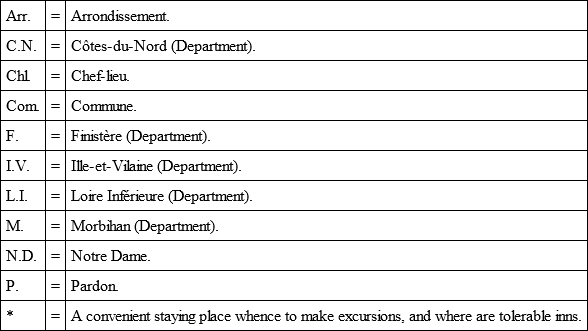
Argentré (I.V.) chl. arr. Vitré. In the neighbourhood are many small lakes, forming one of the arms of the Vilaine, one of the sources of which is in the forest of Pertré. The château de Plessis is of the 15th cent. and has been restored. In it is a portrait of Mme. de Sevigné by Mignard. The circular chapel is of the 17th cent.


